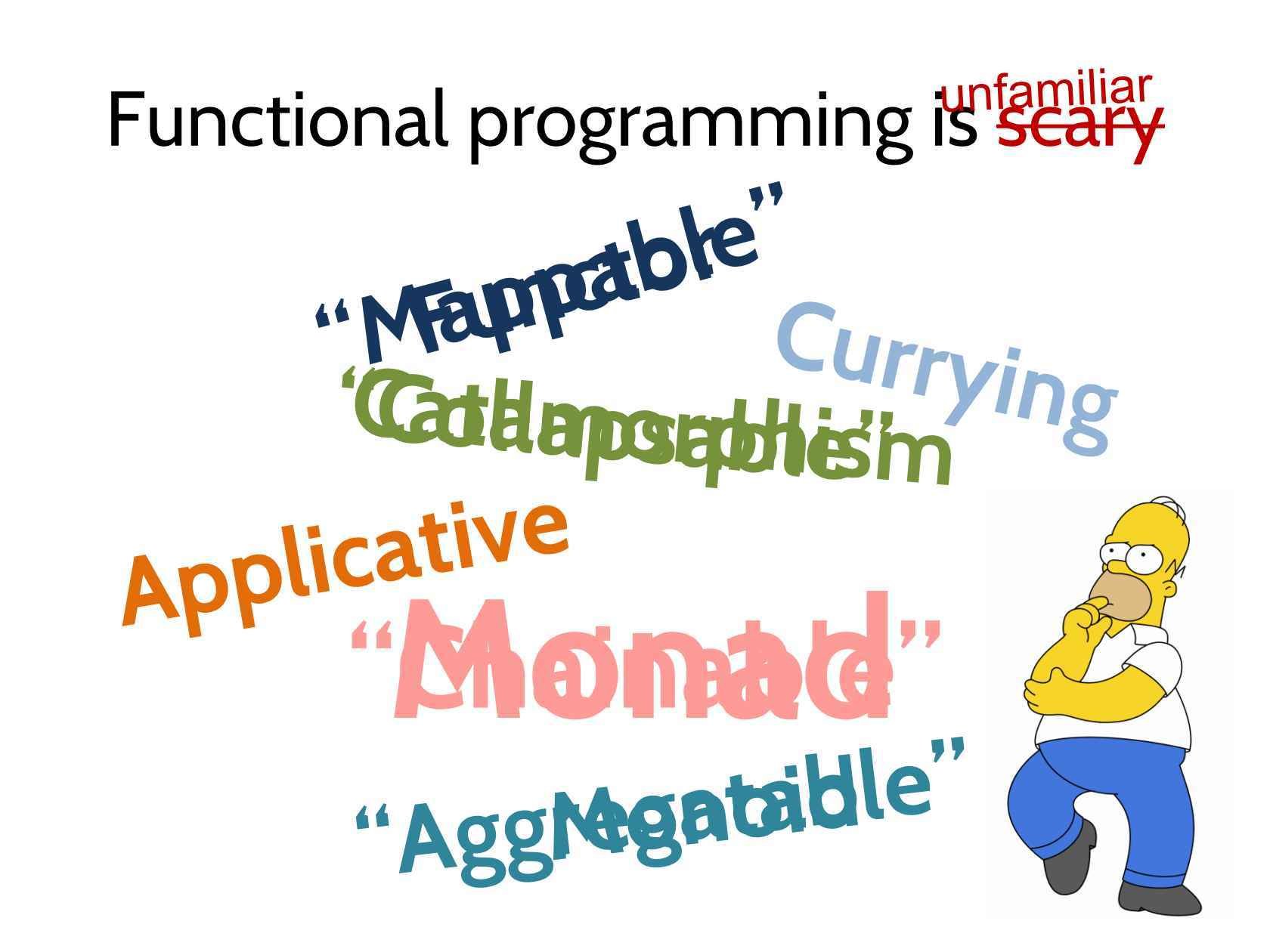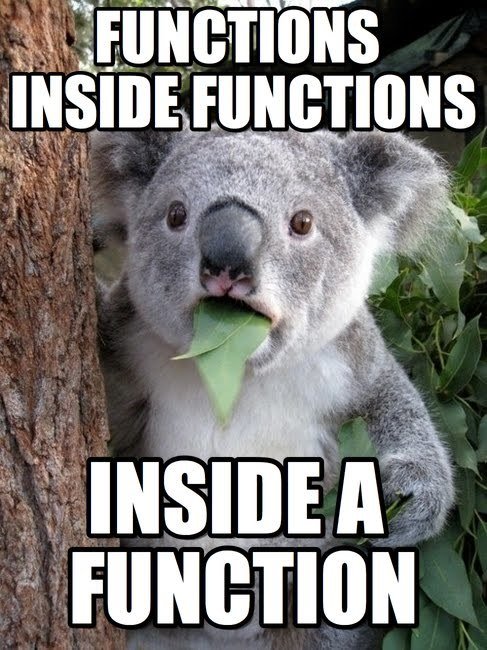Functional Programming
intro
Oleh Makarov
gstancox@gmail.com


Functional Programming is all about programming with functions.
Functional programming is a programming paradigm that follows a more mathematical computation model.
Wiki: Functional programming is a programming paradigm - a style of building the structure and elements of computer programs- that treats computation as the evaluation of mathematical functions and avoids changing-state and mutable data. It is a declarative programming paradigm, which means programming is done with expressions or declarations instead of statements.
Imperative
Declarative
const list = [ 1, 2, 3 ];
// imperative style
const imperative = list[0];
// declarative style
const declarative = firstElement(list);what you want instead of how you want it
// imperative
let makes = [];
for (let i = 0; i < cars.length; i++) {
makes.push(cars[i].make);
}
// declarative
let makes = cars.map(function(car) { return car.make; });we will write expressions, as opposed to step by step instructions
Concepts
- Pure Functions
- First-class/Higher Order Functions
- Function Composition
- Closure
- Currying and Partial Application
- Data Immutability
- Recursive Functions
- Lazy evaluation
- Memoization
- Algebraic Data Types
- etc
What is a Function ?
Math: f(x) = 2x

JS, please: const double = x => x * 2
A function maps input values to output values
Ok, a Pure Function ?
- Given the same input, will always return the same value
double(2) //=> 4
double(2) //=> 4
double(2) //=> 4
...double(5) //=> 10
double(5) //=> 10
double(5) //=> 10
...- No Side Effects
which means that it can’t alter any external state
modify a global variable
raise an exception
write/read data to/from file
ajax
localStorage
Why Pure Functions ?
- Composability, one function can be connected to another.
- Can run in parallel, multi-threading, multi-core, GPU and distributed systems.
- Better debugging and testing.
- Predictability (referential transparency )
First-class functions
You can pass them into other functions as parameters:
You can assign a function as a value to a variable:
You can return a function:
function runFunction(fn, data) {
return fn(data);
}var myFunc = function() {
// do something
};
const myNewGenFunc = someParam => someParam;function takeFirst(f, g) {
return f;
}Higher Order Functions
A function is a higher order function if it takes a function as a parameter, or returns a function as its result.
Array#map
Array#filter
Array#reduce
Examples
map
filter
reduce
const arr = [1, 2, 3];
const square = x => x * x;
const squared = arr.map(square); //=>[1, 4, 9]
const arr = [1, 2, 3, 4];
const isEven = num => num % 2 === 0;
const result = arr.filter(isEven); //=> [2, 4]const numbers = [1, 2, 5];
const sum = numbers.reduce((prev, curr) => prev + curr, 0); //=> 8Function Composition
Composition: “The act of combining parts or elements to form a whole.” ~ Dictionary.com
const increment = (x) => x+1;
const double = (x) => x*2;
const half = (x) => x/2;
const calculate = half(double(increment(3))); //=> 4Function Composition (helpers)
// helpers
const compose = (...functions) => data =>
functions.reduceRight((value, func) => func(value), data)
const pipe = (...functions) => data =>
functions.reduce((value, func) => func(value), data)
// computations
const increment = (x) => x+1;
const double = (x) => x*2;
const half = (x) => x/2;
const calculate = half(double(increment(3))); // 4
const calculateWithCompose = compose(half, double, increment)(3); // 4
const calculateWithPipe = pipe(increment, double, half)(3); // 4
Function Composition (helpers)
half(double(increment(3)));
compose(half, double, increment)(3)
pipe(increment, double, half)(3)RIGHT-TO-LEFT
LEFT-TO-RIGHT
Closure(scope)
A language implements static scope, if only by looking at the source code one can determine in which environment a binding is resolved.
Is the accessibility of variables, functions, and objects in some particular part of your code during runtime.
function sum() {
var a = 1;
var b = 2;
function logSum() {
console.log(a+b);
}
logSum();
}
sum(); // 3let x = 1;
function foo() {
console.log(x);
}
function bar(fn) {
let x = 2;
fn();
}
bar(foo); // 1, not 2!And that is the scope of the creation time
Closure(scope)
Closure
//es5
function foo(a, b) {
return function () {
return a + b;
}
}
var sum = foo(4,5);
sum(); //=> 9
sum(); //=> 9
//es6
const foo = (a, b) => () => a + b;
const sum = foo(4, 5);
sum(); //=> 9
sum(); //=> 9
A closure is the combination of a function and the lexical environment within which that function was declared.
Currying
Сurrying is the process of breaking down a function into a series of functions that each take a single argument.
const sum = (x, y, z) => x + y + z;
sum(1, 2, 3); //=> 6
// es5
const sum = function(x) {
return function(y) {
return function(z) {
return x + y +z;
}
}
}
sum(1)(2)(3) //=> 6
// es6
const sum = x => y => z => x + y + z;
sum(1)(2)(3) //=> 6sum(1);
//=> [ Function ]
sum(1)(2);
//=> [ Function ]
sum(1)(2)(3);
//=> 6// lodash, baby
_.curry(sum)
sum(1, 2, 3) //=> 6
sum(1, 2)(3) //=> 6
sum(1)(2, 3) //=> 6
sum(1)(2)(3) //=> 6
Partial (Function) Application
In computer science, partial application refers to the process of fixing a number of arguments to a function, producing another function of smaller arity.
let add = x => y => x+y;
let increment = add(1);
let incrementBy2 = add(2);
increment(3); //=> 4
incrementBy2(3); //=> 5// lodash partial
function greet(greeting, name) {
return greeting + ' ' + name;
}
var sayHelloTo = _.partial(greet, 'hello');
sayHelloTo('fred');
// => 'hello fred'
// Partially applied with placeholders.
var greetFred = _.partial(greet, _, 'fred');
greetFred('hi');
// => 'hi fred'Immutability (principles)
- Data is immutable. It is never mutated in-place.
- Changes to data are encapsulated into operations that take a previous version and return a new one.
- History is represented as a list of states,
- Modifying data causes any future states to be thrown away.
Immutability (pros)
- Safer code (No invalid state)
- Comparing state difference is as easy as comparing their references
- Easier to Debug
- Undo / Redo (Back-tracking made easy with persistent data)
-
Thread safety
Immutability (cons)
Performance
Copying wastes time and space
Immutability (javascript)
// Assignment immutability
const z = [1, 2, 3]
z = [4, 5, 6] // not allowed
// TypeError:Assignment to constant variable
z[0] = 4 // allowed [4, 2 ,3]
// Value immutability (shallow)
const f = Object.freeze([1, 2, 3]);
f[0] = 4 // not allowed
console.log(f) // [1, 2, 3]
const fs = Object.freeze([1, 2, 3, [4, 5, 6]]);
fs[0] = 4 // not allowed
fs[3][0] = 1 // allowed
console.log(fs) // [1, 2, 3, [1, 5, 6]]Immutability (libs)
Immutable JS data structures which are backwards-compatible with normal Arrays and Objects.
var array = Immutable(["totally", "immutable", {hammer: "Can’t Touch This"}]);
array[1] = "I'm going to mutate you!"
array[1] // "immutable"
array[2].hammer = "hm, surely I can mutate this nested object..."
array[2].hammer // "Can’t Touch This"
for (var index in array) { console.log(array[index]); }
// "totally"
// "immutable"
// { hammer: 'Can’t Touch This' }
JSON.stringify(array)
// '["totally","immutable",{"hammer":"Can’t Touch This"}]'
// Uses Object.freeze
Immutable([3, 1, 4]).sort()
// This will throw an ImmutableError, because sort() is a mutating method.Immutability (libs)
Provides many Persistent Immutable data structures including: List, Stack, Map, OrderedMap, Set, OrderedSet and Record.
var list = Immutable.List([1, 3, 2, 4, 5]);
popedList = list.pop().pop(); // [1, 3, 2];
// popedList === list => false
updatedList = list.push(6); // [1, 3, 2, 4, 5, 6]
// updatedList === list => false
console.log(updatedList.get(0)) // 1
updatedList.set(0, 4)
console.log(updatedList.get(0)); // 1
const array = updatedList.toJS(); // [1, 3 , 2, 4, 5, 6]
Immutability (libs)
ClojureScript's persistent data structures and supporting API from the comfort of vanilla JavaScript
var inc = function(n) {
return n+1;
};
mori.intoArray(mori.map(inc, mori.vector(1,2,3,4,5)));
// => [2,3,4,5,6]
//Efficient non-destructive updates!
var v1 = mori.vector(1,2,3);
var v2 = mori.conj(v1, 4);
v1.toString(); // => '[1 2 3]'
v2.toString(); // => '[1 2 3 4]'
var sum = function(a, b) {
return a + b;
};
mori.reduce(sum, mori.vector(1, 2, 3, 4)); // => 10
//Lazy sequences!
var _ = mori;
_.intoArray(_.interpose("foo", _.vector(1, 2, 3, 4)));
// => [1, "foo", 2, "foo", 3, "foo", 4]Recursive Function
function sumIter(sum, ...nums) {
for(var i = 0; i < nums.length; i++) {
sum = sum + nums[i]
}
return sum;
}
sumIter(1, 2, 3) // => 6
function sumRecur(sum, ...nums) {
if (nums.length == 0) return sum;
return sum + sumRecur(...nums);
}
sumRecur(1, 2, 3) // => 6
Recursive Function(proper tail calls)
'use strict'
function sumRecurPTC(sum, num, ...nums) {
sum += num
if (nums.length == 0) return sum;
return sumRecur(sum, ...nums);
}
sumRecurPTC(1, 2, 3) //=> 6OOP
FP

In all programs, there are two primary components: the data (the stuff a program knows) and the operators (the stuff a program can do to/with that data)
When FP? And when OOP?
"In a fight between a bear and an alligator, the terrain determines the outcome."

Functional programming
Object-Oriented programming
- Objects (understandable)
- Imperative style
- Shareable state
- Reliable (pure) functions (no side effects)
- Declarative style
(refactoring)
- A "newer" paradigm
- Readability
Material(Books)


Q&A